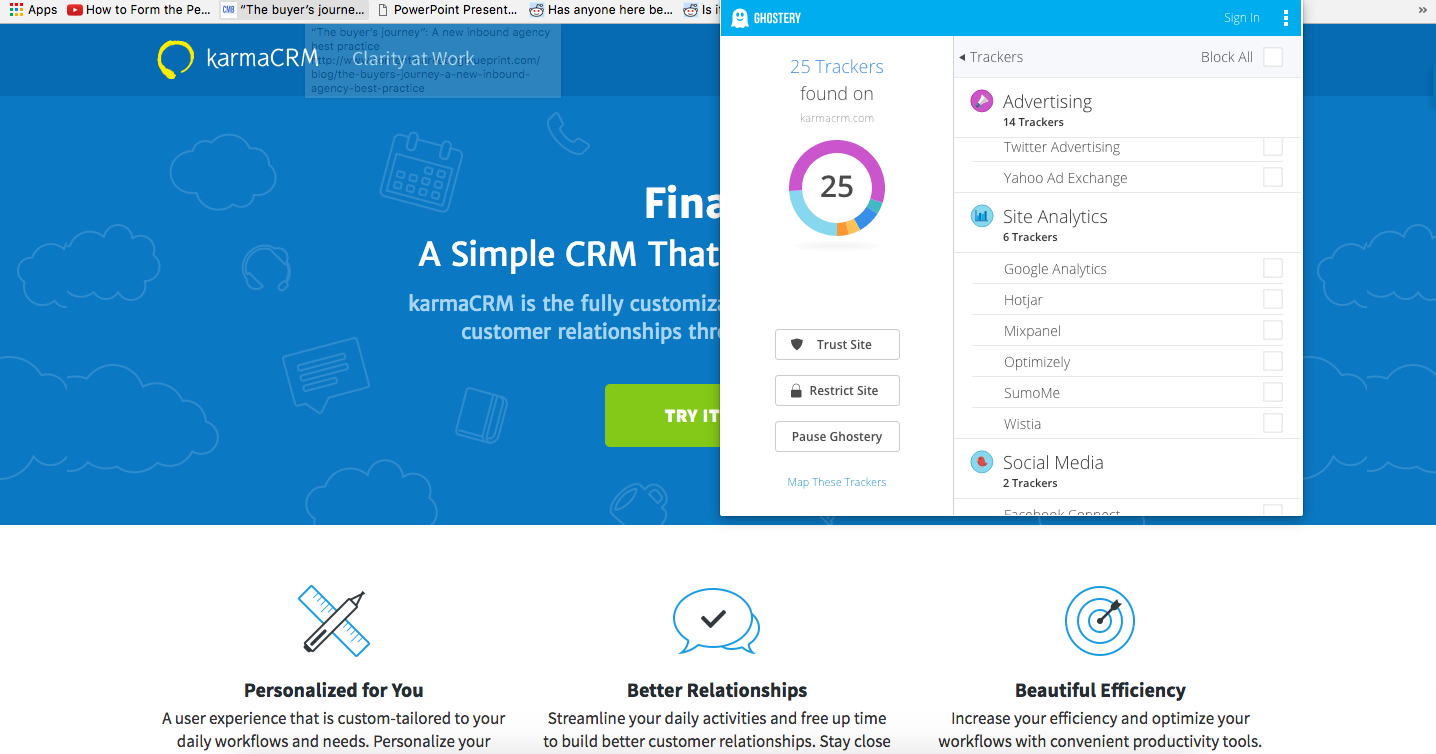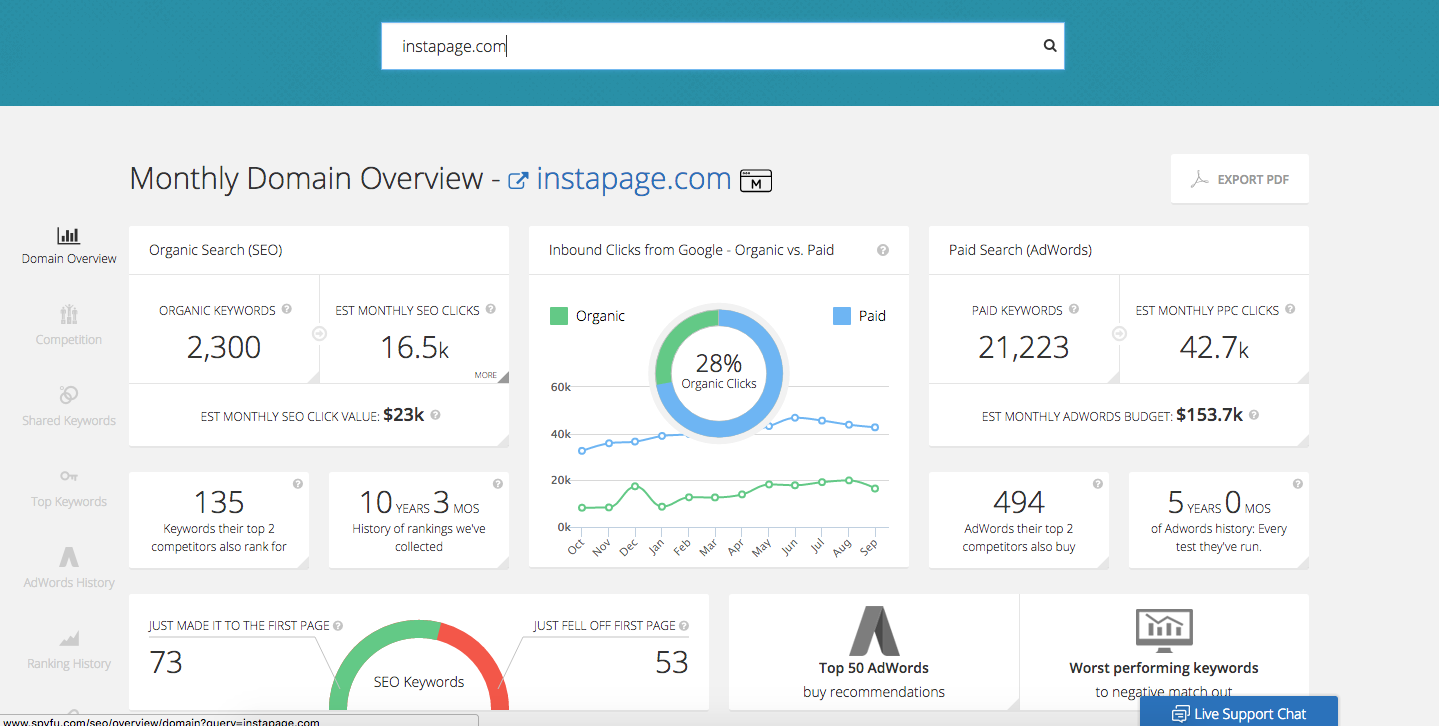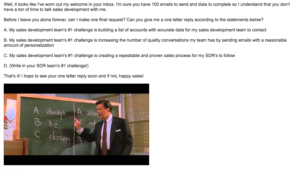Do you find yourself with multiple B2B SaaS ideas floating around in your head that you think could be $100 Million ideas? Have you also sat on those ideas and done nothing because have no idea whether or not they would be something businesses would pay for?
I’ve been lucky enough to speak with dozens of entrepreneurs in the B2B SaaS space that are in this same familiar predicament. They have what could be a very good idea, but no reliable way to contact and interview potential users to find out if their idea is solving a real problem.
Since many entrepreneurs don’t know how to obtain these customer interviews, they tend to forgo the practice. More often than not, this results in a product that doesn’t solve a problem that your customers will pay for.
Instead of avoiding customer development interviews, you can obtain 25 interviews with businesses that could end up being your first customers. That’s what I’m going to show you in this post (Part 1 of a 2 part series).
We’ll discuss how to:
- Identify who I wanted to speak with
- Build a targeted list of companies & individuals
- Find and verify email address
- Craft my message
- Send a 3 step email sequence
Ready to get started? Let’s go.
Step 1: Identify who you want to speak interview
Before you decide to write a single email, you need to have a “hypothesis” about who your ideal customer is. I say hypothesis because as an early stage startup who has yet to validate any assumptions, you are working off your best guest. You don’t know anything for sure until you speak with customers.
I’m currently in the process of obtaining customer development interviews for a product called Beam. Beam is a company born from Nugget #14 and we believe it will become a SaaS platform that helps marketing agencies, startups, and tech-enabled small to medium sized businesses to reduce and control unnecessary SaaS spend. Our ideal customer profile is:
ACME. Corp is a US Based marketing agency, startup, or tech-enabled SMB whose employees frequently trial, and purchase cloud software. They employ 20 – 100 people and have at least 3 corporate credit cards and accounts in which they purchase SaaS solutions.
Employees at this company are welcome to create and try different products at will. They will often make joint decisions as to what products they will purchase and they don’t have a central place to identify what software solutions everyone across their company is using. ACME. Corp lacks information as to how much their current software solutions are being used.
Decision makers that would use Beam include people looking to manage overall company spend, manage IT security, monitor employee engagement with their SaaS platforms. These decision makers could include the CEO, CFO, and head of IT.
To identify and create an ideal customer profile hypothesis like the one above, start by asking yourself these questions:
- What industry is my ideal prospect’s company in?
- What’s the size of your ideal prospect’s company?
- What is the pain point we believe our prospect will be feeling?
- What is the most likely job description of your ideal prospect?
- Based off the above job description, what is the most likely job title of your ideal prospect?
Based off these questions, you should be able to come up with a basic ideal customer profile similar to the one above.
Please note that your ideal customer profile is subject to changes and refinement. As you gather more information and start to sell your solution, your ideal customer profile will include things like:
– Customers with the shortest prospective sales cycle
– Customers with the highest probable conversion rates
– Customers with certain technologies that are complimentary to your product
– Customers with certain technologies that are competitive to your product
Step 2: Build a list of Target Companies & individuals
Now that you have your basic ideal customer profile, you can build a list of target companies.
You can easily build a list based off the job title that you are targeting. LinkedIn has a powerful boolean search engine with tons of filters for both the free, and paid versions of Linkedin.
Pro tip: Invest in LinkedIn Sales Navigator if you’re serious about your business. $80 is a small price to pay for access to the largest business network in recorded human history!
Using Linkedin, search for the appropriate job title and filter by company size, industry, Fortune 500 status, and more. You can filter individuals by seniority level, interests, past companies, schools, and even nonprofit interests.

If you aren’t 100% sure of the titles you want to target, pay close attention to the current and previous company job descriptions of your prospects. Job titles are often vastly different from company to company in terms of what a person actually does. So even if the job title doesn’t completely match up to your hypothesis, they could still be the person you want to speak with.
If you want to target companies using a specific technology, you can build a list of companies that fit all of your other criteria, and check each URL with one of the following tools.
These tools will allow you to see what technologies a specific URL is using. In the picture below, karmaCRM is using 25 technologies including Google Analytics, SumoMe, and Optimizely.

You can expedite this process by hiring a VA to check each URL on your list via UpWork.
You can also identify companies that have a certain amount of ad spend or SEO clicks via a tool called SpyFu.
Simply take build a list of companies that fit all of your other criteria, and check each URL with spyfu.com. As you can see in the screenshot below, Instapage would be a great target if your ideal customer profile called for SaaS providers with a significant amount of ad spend.

Step 3: Find and verify email addresses
As you find prospects, you’ll want to grab and verify the email addresses of these potential interviewees. There are a number of different tools that you can use to find these email addresses. These include:
– Leadfuze
– SellHack
These services do a great job of finding email addresses, however, they are usually only correct about 80% of the time. You can use services like Rapportive, and BriteVerify to double check that your email addresses are correct.
Step 4: Craft your message
Now that you have your lead list, you can begin to craft your outreach messages. It’s important to do this AFTER you build a list because you’ll want to customize each message for each prospect. That’s right, you won’t be able to just send out a mass email and see results. Don’t worry though! I’m here to show you how you can personalize these messages and still be efficient.
Use the 10/80/10 rule
Templates can be your best friend and your worst enemy when you’re doing cold outreach. If you rely too heavily on templates, your emails will be cold, impersonal, and come off as spam. However, proper templating can actually help you stay efficient even while you personalize.
The best way to use a template is by concentrating on customizing the first 10% and the last 10% of each email. This is called the 10/80/10 rule. These are the most important parts of the email because they are the first and last impression your prospect gets of you, and you want to leave a great impression.
The initial 10% should be customized according to why you decided to reach out to them. I call these reasons “Compelling reasons to reach out” (CRRO). These reasons could include:
– An interesting blog post that they wrote
– An article they shared on LinkedIn or Twitter
– A recent hiring at their company
– A recent fundraising event
– A recent article on press release published about their company
– A technology used
– A significant amount of ad spend
Based on these reasons to reach out, you can create common snippets that you use like these below:
CEO/Executive Statement
In a recent interview, the CEO of {{company}} stated that {{interesting.fact}}
Company News
Last week, {{publication}} posted an article called {{article.title}} which detailed how {{company}} {{interesting.fact}}
Blog Post
I came across your blog post called {{blog.title}} in which you talked about {{interesting.fact}}
Job Posting
I was doing a bit of research into {{company}} and noticed that you guys were growing your {{team.function}} team (saw post via {{linkedin}}). {{interesting.fact}}.
Ad spend
I did a bit of research into {{company}} and saw that you’re driving a ton of traffic via AdWords. Are you getting a lot of traction from keywords like {{keyword_1}} and “{{keyword_2}}“?
Technology usage
I noticed {{company}} was using {{technology_1}} and thought I’d reach out because I’m trying to understand how {{technology_1}} users are {{solving.complementary.problem}}
Middle 80%
With this middle 80%, your goal is to give them an idea as to what you’re going to be speaking to them about and to reassure them that this IS NOT A SALES CALL.
This section should be templated. Focus on being brief, flattering, and intriguing. Check out what I crafted below.

This works well because it’s simple, doesn’t come off like a sales pitch, and flatters the reader.
Bottom 10%
The bottom 10% should express to your prospect why you have chosen to seek out their help specifically. This can be as simple as because they are in a given position, because they have had a certain experience, or because they are in a certain location or a went to a certain school. Check out some examples below.
Certain position
Since you are the {{title}} at {{company}} I thought you would be a great person to talk to about this.
Certain amount of experience
I was hoping to talk to someone with {{experience}} experience, so I’m really looking forward to speaking with you.
Step 5: Send Send Send!
Once you’ve crafted your first personalized email message, you’ll need to also create at least 2 additional follow up emails. Kindly following up with your prospects increases your chances of landing an interview significantly because your prospect simply has more opportunities to respond. It is best to make use of systems like CadenceIQ, ReplyApp, PersistIQ, or ToutApp in order to send these emails and remember to follow up. Sending out your emails through Gmail can be tedious and severely cuts down on your efficiency. It also makes it difficult to remember to follow up with potential interviewees which is critical to your success.
Your follow up message for email #2 should be a short and simple email to bump your first message. Check out a screenshot of what I like to include in my second message below.
![]()
With follow-up email #3, I have had success by adding a simple survey to my emails along with just a little bit of creativity. This will intrigue your prospect and can spur them to answer your survey question. When they do respond, you can start to build on the conversation by asking questions and adding value.
Check out one of my favorite final emails below:

Reap the rewards!
When done correctly, you’ll be rewarded with the customer development calls that you need to help you build a successful business. I’ve seen anywhere from 25% – 40% reply rates with these emails, so while success isn’t guaranteed, you should see results if you take the time to do this carefully.
Check out a few response I received below.



Bonus Step!: A 10-Second Primer on the ethics of Cold Emailing
Cold outreach is an effective method of obtaining interviews and sales and has been the driving force behind most unicorn SaaS startups such as Hubspot (yes Hubspot, the inbound marketing platform), SalesForce, Mulesoft, Zenefits, and more. Despite how effective it can be, cold emailing can easily do damage to your brand if not done correctly.
Cold, non-personalized messages are spammy, unprofessional, and annoying. So when employing these tactics, please remember to take care to not spam your prospects and do your best to intelligently and kindly provide value. Also, ensure that you are following all CAN-SPAM laws. These most include the following:
- Don’t use false or misleading header information.
- Don’t use deceptive subject lines.
- Tell recipients how to opt-out of receiving future email from you.
- Honor opt-out requests promptly.
Check out any additional CAN-SPAM documentation here.
Update! Tool & Resource Listing
Finding email addresses:
– Rapportive
– Hunter.io
– Name2Email
– Leadfuze
Email followups:
– Boomerang
– ReplyUp
– Reply.io
– Persistiq
– Gorgias.io (Gmail email templates)
Listbuilding
– Linkedin
– Angel.co
– Stackshare
– Crunchbase
– Data-miner.io
– Datanyze
– Wappalyzer
Cold email personalization snippet examples
Now you have the tools to find customers to talk to. So what are you waiting for? Get out there and validate your idea! If you are having trouble coming up with your next idea, check out Nugget.
. . .
Nugget is an online incubator & community. We help founders start and grow profitable side projects.
